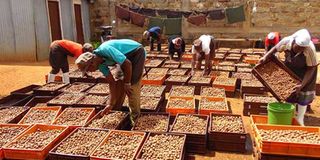Kenya to host macadamia meeting as growers increase

Workers drying macadamia nuts at a factory. Increased small-scale production of macadamia nuts in Kenya has won global recognition with the country set to host the 9th International Macadamia Symposium in August 2021. PHOTO | FILE | NATION MEDIA GROUP
What you need to know:
- Last year’s symposium estimated global production will increase from the current 200,000 tonnes to 276,000 tonnes in 2020.
- Mr Muigai says the Chinese government offers vital lessons on how the Kenyan government can offer more support to the industry.
- Processors have created an installed processing capacity of 90,000 tons and are currently operating at 50 percent.
Increased small-scale production of macadamia nuts in Kenya has won global recognition with the country set to host the 9th International Macadamia Symposium in August 2021.
The festival, held every two years, brings together experts, scholars, entrepreneurs and growers from around the world to share their achievements and chart the future development of the industry.
Nut Processors Association of Kenya (NutPAK) Chief Executive Officer Charles Muigai said Kenya was chosen to host the event due to the success the sector has recorded through small-scale farming, which typifies the country’s production system. The association is one of the main organisers of the symposium expected to be attended by 800 delegates.
SMALL SCALE FARMS
While other producers such as China, South Africa and Australia deal with large-scale plantations, Kenya has about 200,000 small farms currently producing an estimated 42,500 tonnes in-shell, which constitutes about 20 percent of the global supply, according to NutPAK.
Last year’s symposium estimated global production will increase from the current 200,000 tonnes to 276,000 tonnes in 2020.
“The symposium's prevailing sentiment was that all macadamia producing regions need to work towards increasing investment in production and marketing. As the world moves towards the production volumes forecast for 2020, a sound marketing strategy will be required in order to drive the demand needed to soak up the growing supply,” Mr Muigai said.
He appealed to the government to be one of the main sponsors of the coming symposium.
LESSONS FROM CHINA
According to Mr Muigai, the Chinese government offers vital lessons on how the Kenyan government can offer more support to the industry.
The government of China has supported the macadamia sector with the funding of the International Macadamia Research and Development Centre established to promote the industry.
“China now has up to 200,000 hectares under plantation and will be the fourth-largest producer this year at around 20,000 tonnes. Up to 80 percent of farms in the largest growing region of Yunnan are owned by small growers with the government supporting them,” Mr. Muigai said.
Small-scale farmers in Mt Kenya region in the recent years have abandoned traditional cash crops for macadamia nuts.
Since the ban of export of raw nuts in 2009, production of the nuts has risen from an annual production of 11,000 metric tonnes and four processors to over 45,000 metric tons and 30 processors by 2018, according to statistics by NutPAK.
INCREASED PRODUCTION
Anticipating increased production in the next five years, processors have created an installed processing capacity of 90,000 tons and are currently operating at 50 percent.
The targeted areas of production are the non-traditional ones such as Uasin Gishu, Elgeyo-Marakwet and Nandi counties in efforts to prop up production.
The Agriculture and Food Authority (AFA) will supply at least three million seedlings to farmers in an attempt to scale up production from the current 41,000 tonnes to about 61,000 tonnes in the next five years, Mr Richard Ndegwa, interim head of the Nut and Oil Crops Directorate at AFA said in an earlier interview.
The demand for increased production of the nut is fuelled by attractive farm gate prices that hit the Sh200 mark per kilo at the close of the last season in August 2018.





